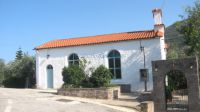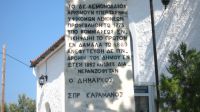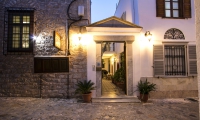Sightseeing in Central Trizina
From the little Church of Saint Apostoli, up to the junction of the road that goes from Galatas towards Μetamorphosi and Methana, we can go SW towards Trizina (1st exit) or back to Kalloni or SE towards Galatas. We turn left towards Galatas and in about 3.5km we can see on our left a junction towards Vydi which we follow.
The coastal area east of the Taktikoupoli peninsula that overlooks the Poros Strait, has the features that make Trizinia stand out. Isolated, peaceful, a return to the past. Our first stop on the left of the road is the little Church of Saint Georgios after 300 metres. From there, after 500 metres we arrive at Vydi with its picturesque bay. At today’s Vydi was situated the ancient harbour of Pogonas, where part of the Greek navy arrived before the Battle of Salamina.
Just before the small bridge, on our right, the little Church of the Dormition of the Virgin Mary stands out. The church, which was extensively renovated in 1970, was built on the remains of the old monastery that was destroyed by the Bavarians of Otto in 1834. This monastery was one of four in Trizinia (Zood. Pigi of Poros, St Athanasios and St Dimitrios the other three).
The small harbour at Vydi is worth stopping to enjoy. The sea is like a lake, a narrow small harbour with some rowing boats and in the background the Poros Strait, all these coming together to make up a landscape of complete serenity and natural beauty.
Immediately after the little bridge, far back to our right there stands out a large, ruined building that architecturally looks like an old industrial unit. Indeed, it is an old wood factory which initially functioned as an olive press. It is a characteristic example of the industrial architecture of the 1st half of the 20th century.
We continue our route moving along the coast (on a marshy dirt road). To our right is the Poros Strait, which is not really attractive for swimming (as the bay is very closed and has the characteristics of a lagoon) but it does give us impressive pictures. In addition, since the water is usually very calm, it is an ideal place for water skiing. At about 700 metres from Vydi, we pass by a deserted, abandoned, haphazardly built residential area and in another 3km we end up at the Bay of Agios Nikolaos, with a small beach and the little Church of Saint Anargiri at its far end. It was renovated by the monk Makarios in 1984. The road continues from here and in another 3.5km returns to Taktikoupoli, to complete in this way circumferentially a sightseeing of the peninsula of Taktikoupoli.
Returning to the road towards Galatas, we turn left and after 650 metres we pass by the village of Agios Georgios on the road, with its grand Church of Saint Georgios. From Agios Georgios, after about 500 metres to the right in a SW direction, we can see the signs towards Trizina and the archaeological site there. We turn right and after 3km we arrive at historic Trizina.
Trizina is the most important historic and traditional village of the region. It is situated in the northern foothills of the Aderes. Location of 3rd National Assembly of the free regions of Greece in 1827. The venue of the National Assembly has not been given prominence as yet but that is planned to shortly happen.
In the village, apart from the venue of the 3rd National Assembly, of special interest is its very beautiful spacious square with a view towards the valley, and its two main churches, of Saint Leonidis who lived here during the 3rd century AD and is the patron Saint of Trizina (we learned of the Saint with our visit to his little church below Dryopi) and higher up (opposite the venue of the 3rd National Assembly) the parish church of Trizina in honour of Saint Ioannis. According to tradition, on this site was a small church of the 13th century dedicated to St Ioannis Chrysostom. The church was renovated in the 17th century and in 1952 was rebuilt with donations from the Trizina migrants to America.
From this point the road goes up the slopes of the Aderes and takes us after 1.5km to the Monastery of Saint Dimitrios. An important historic monastery of Trizinia, founded in 1455,at its peak it had 100 monks and during the years of 1821, it was a meeting place for the Society of Friends and fighters. Subsequently, it fell into disuse although works of reconstruction have taken place in recent years.
We return to Trizina to visit another very well-known contemporary monastery of the region, the Monastery of Kecharitomeni. The monastery is also situated on the slopes of the Aderes, 3.1km from the village. It is a monastery for men, impressive in the size of the building, founded in 1976 by the late Gerontas Father Epiphanios Theodoropoulos (1989). It is worth continuing on the footpath for another 200 metres following the sign towards Agios Panteleimonas. The road ends in very beautiful natural surroundings in which the little Church of the Saint, built in 1870, is situated. From Agios Panteleimonas there starts a lovely forest footpath, which is worth walking towards the Chapel of Saint Paraskevi. The marshy footpath is 700 metres long and is a 10 minute walk.
We return to the village of Trizina with the intention this time of exploring the very important ancient findings of the region. The archaeological site of Trizina, with the Shrine of Hippolytus, extends NW of Trizina village. The excavations of the site were first initiated by the French Archaeology School in 1890 and 1899 followed later in 1932 by the German Archaeological Institute. To get to the site, we follow a NW direction from the village (there is also relevant signposting).
After 600 metres, we arrive at a junction. At the fork of the junction there stands out a massive worked rock that is believed to have been called by the ancient Trizinians the stone of Theseus (referred to by Pausanias). This rock was easily lifted by Theseus who took the sword and sandals that had been left by his father. Throughout the ages, many rocks have been given the same distinction!
At the crossroad, the road straight ahead goes towards the archaeological site and the temple of Hippolytus while to the left towards the ancient citadel and the devil’s bridge (signposted).
Up to the crossroad, the road is a marshy dirt road but from the left turn and after it gets worse and requires a high chassis car. A few metres after having taken the left direction, we can see on our right, buildings (Roman) that have been identified as the Shrine of the Muses.
The ancient town of Trizina is located several hundred metres NW from todays village of Trizina (that was formerly called Damalas in medieval years). It is thought that on the same site was built the medieval castle of Damalas. Of the fortified wall and cross-wall of the ancient town there have been saved only some sections and the most characteristic of these (and re-erected) called the Cross-Wall Tower, can be seen from the Shrine of the Muses at a distance of about 200 metres.
Essentially, the area of the ancient citadel of Trizina, where the royal palace was situated, starts above todays cross-wall tower. The few remains are buried in thick undergrowth of yew and oak trees. We can see them if we take the footpath that starts above the Tower, but a few metres on it gets lost in the thick undergrowth. From the other side of the road, below the Tower we can again see ruins of Roman buildings.
From the Cross-Wall Tower the road continues for about 500 metres (where it also ends) bringing us close to a monument of Nature, the renowned Diavologefyro (the Devil's bridge). It is an ancient natural bridge that unites two steep rocks between which flows the water of the River Gephyraios (Diavolorema or Chrysorroas).
Crossing the Diavologefyro, we turn right and go down following the steep footpath. Going down we can hear ever more clearly the rumbling of the River Chrysorroas’ water, which at this point forms two deep, small lakes suitable even for swimming (for those who do not get cold). Generally speaking, and depending on the weather conditions, the crossing of the Diavolorema, to whatever extent you wish, is a breathtaking experience, but it is good not to undertake it alone or without someone who knows the area.
We return to the junction of the stone of Theseus and this time we follow the direction towards the archaeological site. If you are interested, a few metres to our right, in the orchards, is situated the little Church of Saint Georgios. We continue straight ahead and after 200 metres we can see the little Church of Saint Ioannis of Prodromos. The little church is built on the site of the ancient agora of Trizina, close to the temple and the buildings that were mentioned by Pausanias. Here was laid to rest Professor Chr. Phourniadis who had dedicated a large part of his life to the promotion of the antiquities of the region.
From Agios Ioannis the road continues and after about 600 metres takes us to the free entrance of the archaeological site in idyllic, natural surroundings completely attuned to the history of the area. The Shrine of Hippolytus in Trizina connects directly with the myth of Phaedra’s love for Hippolytus. The shrine is located outside the wall of ancient Trizina, at a distance of about 800 metres from the ancient agora.
On the same site, there is also an important Christian monument. North west of the ancient town, at the site of Epsikopi, were found remains of the old Christian Bishop’s residence which were during the Middle Ages the seat of the Bishop of Damalas. With Episkopi, we round off our visit to the archaeological site of Trizina and we return to the village and from there to our road towards Galatas.
Our next sightseeing trip again concerns an important archaeological site of the region that has been excavated relatively recently. It is the archaeological site of Magoula. From the point where we turn from Trizina towards Galatas, we continue for about 3.8km and at this point a dirt road slopes to the left NW towards the archaeological site of Magoula. Watch out as there is no sign as you come (from Trizina). From the point of the turning, we proceed for about 300 metres and there is a second rusty sign that supposedly shows a right direction. If you realise this in time, you enter an olive grove (with 4X4 or on foot) and go up until the end of the road to find yourselves in front of an important archeological discovery. On this small mound, three arched Mycenaean tombs of the 13th century, 15th century and 16th century were excavated (with many objects inside).
Our exploration, however, does not stop here as to the right of the tombs there starts a small footpath that goes up SE, which after 150 metres ends at some remains of the fortified Mycenaean citadel that also functioned as a fort in the Hellenic era, with a beautiful view towards Poros Strait to the north and Trizina to the south.
We return to our road towards Galatas, and now there is nothing more to hold us back from arriving there (about 2km). At the village entrance, of special interest on the right is the little Church of Saint Anna (with an inscription that writes 1853) with two very tall trees beside it, a cypress tree and a pine tree. It is called the small church of the two lovers because according to tradition, two young lovers were buried here having committed suicide because they had fallen in love despite being relatives. There, where they were buried, sprang up the cypress tree and the pine tree that we can see today.
Galatas is built opposite Poros, from which it is divided by a small strait. Between the two villages there is a frequent (every half an hour) ferry (the trip lasts under 10 minutes). It has developed touristic facilities, with sufficient hotels, accommodation, places to eat and enjoy ourselves. Of special interest is the beautifuly landscaped for lovely walks along the length of the beach and the harbour of Galatas, with a view facing the residential districts of Poros. We can also see several, and decent, beaches mainly towards the SE side of Galatas.
Before making our acquaintance with these beaches, we will explore a little the NW side, following the direction from Galatas harbour in a NW direction, through roads in the village. We can see along the road traditional agricultural farmsteads and houses. Narrow, little roads go vertically (to the right) towards the sea, but these beaches on the water of the Poros Strait are not the best. The water is murky and in general, beyond a visit to see it, it is not worth swimming here. Continuing on our road we pass by the little Church of Saint Sotiras and then we go towards the area of Skala Damalas. The road does not go straight but goes ahead in the shape of the greek letter Pi (Π) that makes the distance to Skala around 4.3km.
Skala Damala is a closed bay that is formed by a narrow stretch of land in the Poros Strait that resembles a lake. Start from the beach that is situated in front of the buildings of the deserted today, hotel complex Stella Maris. This beach is relatively better than all those we have seen in this area of our sightseeing.
In order to enjoy the lovely sea of the Poros Strait, it is much better to move in the direction from Galatas SE towards Ermionida. Of special interest are the four main beaches that we meet in succession on our road.
After 1.3km on the road from Galatas towards the beach of Ermionida, we can see below the road, the family beach of Bouyia, with fine pebbles and sand, opposite the SE limit of the Poros town. After the next 900 metres, behind Poros Marine and opposite the Castle of Eintek on the little island of Bourtzi, we can see the lovely sandy beach of Plaka. It is worth visiting if only for the view of the Poros Strait opposite, as well as to enjoy your swim.
The following beach is that of Aliki, a beach of the homonymous hotel Aliki Beach Hotel. It is a narrow stretch of organized beach whose NW side (towards the sea) faces the Bourtzi with the Castle of Eintek and on its SE side it forms a small lagoon. From Plaka, the distance on foot is under 500 metres but to go by car we have to make a small circle following the road towards Lemonodasos and turning left after it towards the hotel (total distance from Plaka 2.2km).
However, in this direction we first of all visit the well known Lemonodasos. This is a forest with well over 30,000 verdant green, fragrant lemon trees, orange trees and water mills (well known is the water mill at the summit of Lemonodasos which was powered by the water of waterfalls) that constitutes the ideal location for romantic strolls. The substantial cultivation of lemons started at the start of the 19th century. The forest was completely destroyed in 1873 when it was infected by komiasis and was replanted in 1882-1883 with the participation of the Local Authorities. Since 2006, the lemon production in Lemonodasos has been abandoned.
Many things have been written about this particular place, the best known is the homonymous novel by Kosmas Politis, written in 1930.

 Today, we can find the beginning of Lemonodasos, 1km from Plaka to the right. Entering the area we can see the all white little Church of St Serapheim, built around 1900. During the litany of his holy skull, the locals prayed for his help when the area was invaded by locusts. To go up higher to better see the extent of the area, it is better to take the dirt track that goes to the right before we arrive at Saint Serapheim. The road goes up rather steeply and reaches a point where there used to operate a tavern.
Today, we can find the beginning of Lemonodasos, 1km from Plaka to the right. Entering the area we can see the all white little Church of St Serapheim, built around 1900. During the litany of his holy skull, the locals prayed for his help when the area was invaded by locusts. To go up higher to better see the extent of the area, it is better to take the dirt track that goes to the right before we arrive at Saint Serapheim. The road goes up rather steeply and reaches a point where there used to operate a tavern.
We return to the main road to acquaint ourselves with the 4th beach of the area close to Galatas, the Artimos. It is a long, narrow beach (with pebbles and sand), just below the road. Used mainly by local holidaymakers. We can find it 1.2km from Saint Serapheim. There is one more lovely sandy beach, 1.3km from here, which we can see from up on the road, access to this beach is, however, difficult as the area is surrounded by fenced in plots of land!
The road goes up and we continue towards the small hamlet of Saronida, which we reach after 3km. What is of interest is not found here but 7km farther on, at an altitude of 700m, towards the east peak of the Aderes. At the height of Saronida, a road goes to the right NW with a sign showing towards OTE. This road, a marshy dirt road, goes continually up and after 7km takes us to the Tepeleni peak, at 690 metres altitude, where several telecommunication ariels and windmills have been set up. Ahead of us, there is only a half-ruined building that has today been converted into a sheep stable. This was a bunker that was built by the German Nazis in 1941. The building was bombarded, by sea, by the Germans themselves during their withdrawal. The building was not declared a listed building and fell into the state that you can now see. In addition to the bunker, the view is also impressive, towards Galatas, Poros and the Poros Strait. Having enjoyed to the full the view, we can return to Saronida to the point where we started out ascent.



